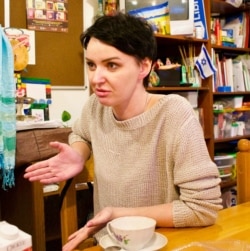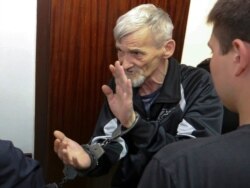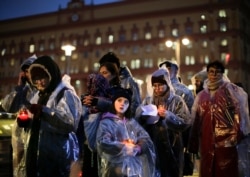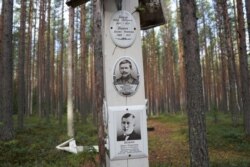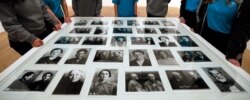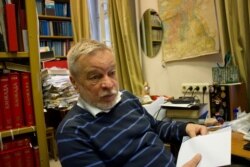Thirty-five-year-old Katerina blinks away the start of tears and says she plans tomorrow to take to the jail warm clothing for winter to her father, Stalin-era historian Yury Dmitriyev.
His decades-long research to expose the scale of the late Communist leader’s terror have met with mounting criticism under Russian President Vladimir Putin and landed him in jail in the Karelian capital of Petrozavodsk in northwest Russia, on what his family and colleagues say are false charges leveled to silence him and to deter others from disrupting the rehabilitation of the late Soviet leader Joseph Stalin.
A slender woman with short-cropped dark hair, she agrees she is as obstinate as her 63-year-old father, a stubbornness softened in both their cases by a lively sense of humor. She laughs recalling the battles they have had over the years. “We have the same character,” she says. “He's a great father. And he's not just my father. He's a friend. And I miss him. He's my best friend.”
His importance in her life and the lives of her two children has become even greater in the wake of her husband’s death six years ago. She had to give up her work to campaign for her father and she visits him twice a month. She says he is holding up but feels the loss of access to serious books. “We aren’t allowed to take him any,” she says. “The prison authorities say we can donate books to the library, but then they add they don’t need any.”
Her obstinacy is crucial now — as is his — battling what Katerina and Dmitriyev’s colleagues say is a state effort to discredit him.
Criminal charges
Dmitriyev, who heads the Karelia branch of the human rights group Memorial, an organization dedicated to documenting Soviet-era purges, has spent two-and-half years locked up since December 2016. Initially he was arrested and charged with taking pornographic photographs many years before of his foster daughter, Natasha. A court-appointed body agreed a year later the images were not pornographic and had been taken for doctors to monitor the development of a sickly child.
But he was subsequently charged with having sexually assaulted Natasha.
Oddly - or possibly suspiciously – he is the second Karelia-based Gulag historian to be charged with child abuse in what some rights campaigners say is eerily reminiscent of the Soviet era when what were described as “ordinary” criminal charges were filed against dissidents to disgrace them, allowing the Kremlin to claim there was no political persecution.
Sergei Koltyrin, the head of a regional museum in the Karelian town of Medvezhegorsk, and also a member of Memorial, was sentenced earlier this year to a nine-year prison term after a closed-door trial while deprived of independent legal assistance.
Documenting Stalin’s Atrocities
For decades Dmitriyev has worked to locate the execution sites and mass graves of Stalin's Great Terror, also known as his “Great Purge,” and to identify as many victims as possible. When he was arrested he was close to finishing a book that had taken nine years to research. It lists the names of 64,000 people deported from across Russia and who died in the forests of Karelia working in appalling conditions and freezing temperatures on construction sites — all in the name of building socialism.
In the mid-1990s Dmitriyev oversaw archival research and excavations which revealed a mass-burial site in a 25-acre pine forest at Sandarmokh, near the Finnish border, where more than 6,000 people were executed and buried at the height of the Stalinist Terror in the mid to late 1930s. Sandarmokh has become a place of pilgrimage, including for Ukrainians paying their respects to 289 Ukrainian writers, playwrights and scientists likely buried there.
And thanks to Dmitriyev, another killing field and mass grave of more than a thousand of Stalin’s victims was discovered in a wooded area 20 minutes from Petrozavodsk at Krasny Bor.
Krasny Bor means the “Beautiful Grove” and but for white-washed wooden markers identifying pits where the killed were buried under tall swaying pine trees it would be.
Erasing History
VOA inspected last month the markers — one has toppled over after being eaten through by termites — and encountered at Krasny Bor a reticent, potbellied taxi driver, Yury. He had waited years to visit after having been told by his grandmother that his grandfather had been shot here. “He owned a mill, that was enough,” Yury said as he read inscriptions on some of the markers.
Yury did not explain why he had waited so long to visit, given that he lives just a half-hour drive down the road. “I had to drop off some people at a dacha near here,” was his only comment. But for many families of those killed in the Great Terror there are mixed feelings, from the shame and pain their spouses felt passed on through the generations, to fear of offending those now in power to a sense that maybe it is best left forgotten for what good can come from the knowledge?
For others it is liberating to know the truth and important knowledge, too, that might prevent anything like it from happening again. And it is respectful of the dead.
Dmitriyev’s work has contributed greatly to the continuing exposure of the cruelty and horror of Russia’s Communist past, complicating the Kremlin's efforts to whitewash the Soviet era, say his colleagues.
Rehabilitating Stalin
Since Vladimir Putin ascended to power two decades ago, Stalin has slowly been rehabilitated and his purges justified. “Putin restored the music of the Soviet national anthem, we have monuments erected to Stalin and the Great Terror justified in textbooks as part of a process that created 'a new class of management suitable to the goals of modernization,’” says journalist and Russian opposition politician Vladimir Kara-Murza. He notes that it is becoming fashionable for Russian officials to put up portraits of Stalin on their office walls.
Dmitriyev’s imprisonment and the struggle to clear his name is part of a battle for history, say his supporters. The historian’s arrest is “part of a pattern to exonerate the Stalinist regime,” says Kara-Murza.
“Dmitriev is in prison for Sandarmokh,” says Anatoly Razumov, director of the St. Petersburg-based Center for the Recovered Names. He has talked with other Gulag historians and “all of us support him, all of us.”
A Crusade for Truth
“I have known Yury for 19 and-half years,” he says. “I know his work, and his personal life as well. I don’t need to think it over. I know all reasons which led to his arrest. Obviously this case is political. Because it’s false. They needed to take him out. As a key person of Sandarmokh. And they did,” he adds.
For the daughter of the imprisoned historian there is no truth at all in the charges that he abused the foster daughter Natasha. “Of course, no, no, no, no! I can’t even imagine how that would be possible,” she says almost angrily when asked. No one knows what’s happening to Natasha, who is in the care of her grandmother, but Dmitriyev’s supporters suspect she’s under considerable pressure from prosecutors.
For Katerina the battle is not for history, but for her father. “For me his job, all his diggings and research, was just a normal job, like a dentist or plumber. Someone needs to do these things,” she says.
But, of course, it was not a normal job, and his daughter knows that, too. “He restores names, he helps people. He found my great-grandfather, from my mother’s side. My grandfather was 60 years old when that happened. And I saw his tears. I understand how important it is. Besides him, I saw many old ladies approach my father to thank him. They cried and were very grateful that he found their relatives,” she says.





